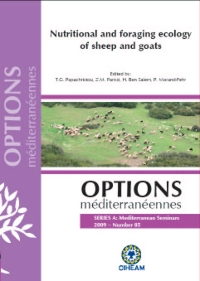| Article précédent | p. 177-179 | Article suivant |
Quantitative aspects of phosphorus absorption and excretion in sheep
The aim of the present study was to compile data from previous studies dealing with true digestibility of different phosphorous (P) sources for sheep. The database consisted of results from some experiments carried out at the Centre for Nuclear Energy in Agriculture (CENA/USP, Piracicaba, Brazil), using sheep fed different sources of P: dicalcium phosphate (n = 14); monoammonium phosphate (n = 12); triple superphosphate (n = 12); bone meal (n = 28); rock phosphates (n = 32). True absorption of phosphorus was determined by the isotopic dilution technique. All parameters (PING: ingested P; PABS: absorbed P; PFECTOT: total faecal P excretion; PFECENDO: endogenous faecal P; PFECNABS: dietary non absorbed P; and PRET: retained P) were normalized according to dry matter intake (DMI) and linear regressions between PING and the other parameters were tested. Excretion of P was affected by intake. Endogenous fraction of faecal P (PFECENDO) was not affected by PING. The present study showed that only 0.37 of ingested P was absorbed, i.e. about two thirds of ingested P were excreted via faeces, contributing to environmental pollution. Some sources of phosphorus can, in the long term, promote environmental damages due to their low availability for the animals.
Le but de la présente étude était de rassembler les données des études précédentes traitant la digestibilité réelle de différentes sources de P chez les moutons. La base de données était composée à partir des résultats de quelques expériences effectuées au Centre de l'Énergie Nucléaire dans l'Agriculture (CENA/USP, Piracicaba, Brésil), utilisant des moutons soumis à différentes sources de P : phosphate bicalcique (n = 14) ; phosphate de monoammonium (n = 12) ; superphosphate triple (n = 12) ; farine d'os (n = 28) ; phosphates de roche (n = 32). L'absorption réelle du phosphore a été déterminée par la technique de la dilution isotopique. Tous les paramètres (PING : P ingéré ; PABS : P absorbé ; PFECTOT : excrétion totale de P fécal ; PFECENDO : P fécal endogène ; PFECNABS : P diététique non absorbé ; et PRET : P maintenu) ont été normalisés selon la prise de matière sèche (PMS) et des régressions linéaires entre le PING et les autres paramètres ont été examinées. L'excrétion de P a été affectée par la prise. La fraction endogène de P fécal (PFECENDO) n'a pas été affectée par le PING. La présente étude a démontré que seulement 0,37 de P ingéré a été absorbé, par ex., environ deux tiers du P ingéré ont été excrétés dans la matière fécale, contribuant à la pollution environnementale. À long terme et à cause de leur faible disponibilité, quelques sources de phosphore peuvent avoir des répercussions négatives sur l'environnement.
- [ Afficher ]
- [ Télécharger ]
- [ Exporter la citation ]
Vous pouvez télécharger la citation au format :
- [ Imprimer ]
-
Mots-clés
DIGESTIBILITE, ENVIRONNEMENT, EXCRETION, FECES, OVIN, PHOSPHORE, POLLUTIONCiter cet article
Bueno I.C.S., Lopes J.B., Sallam S.M.A., Abdalla A.L., Vitti D.M.S.S. Quantitative aspects of phosphorus absorption and excretion in sheep. In : Papachristou T.G. (ed.), Parissi Z.M. (ed.), Ben Salem H. (ed.), Morand-Fehr P. (ed.). Nutritional and foraging ecology of sheep and goats. Zaragoza : CIHEAM / FAO / NAGREF, 2009. p. 177-179. (Options Méditerranéennes : Série A. Séminaires Méditerranéens; n. 85). 12. Seminar on: Nutritional and Foraging Ecology of Sheep and Goats, 2007/10/11-13, Thessaloniki (Greece). http://om.ciheam.org/om/pdf/a85/00801004.pdf



